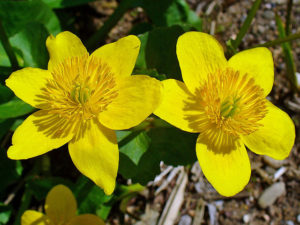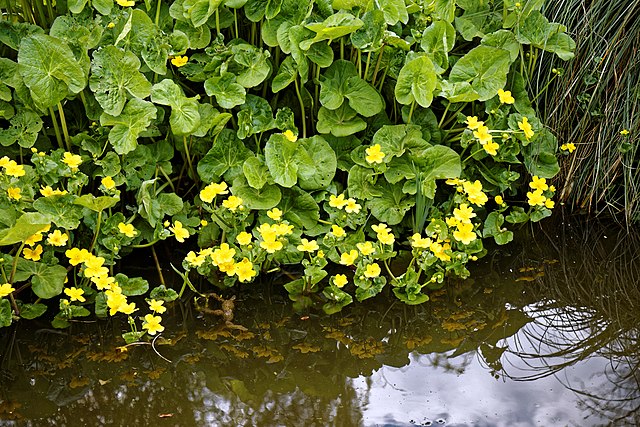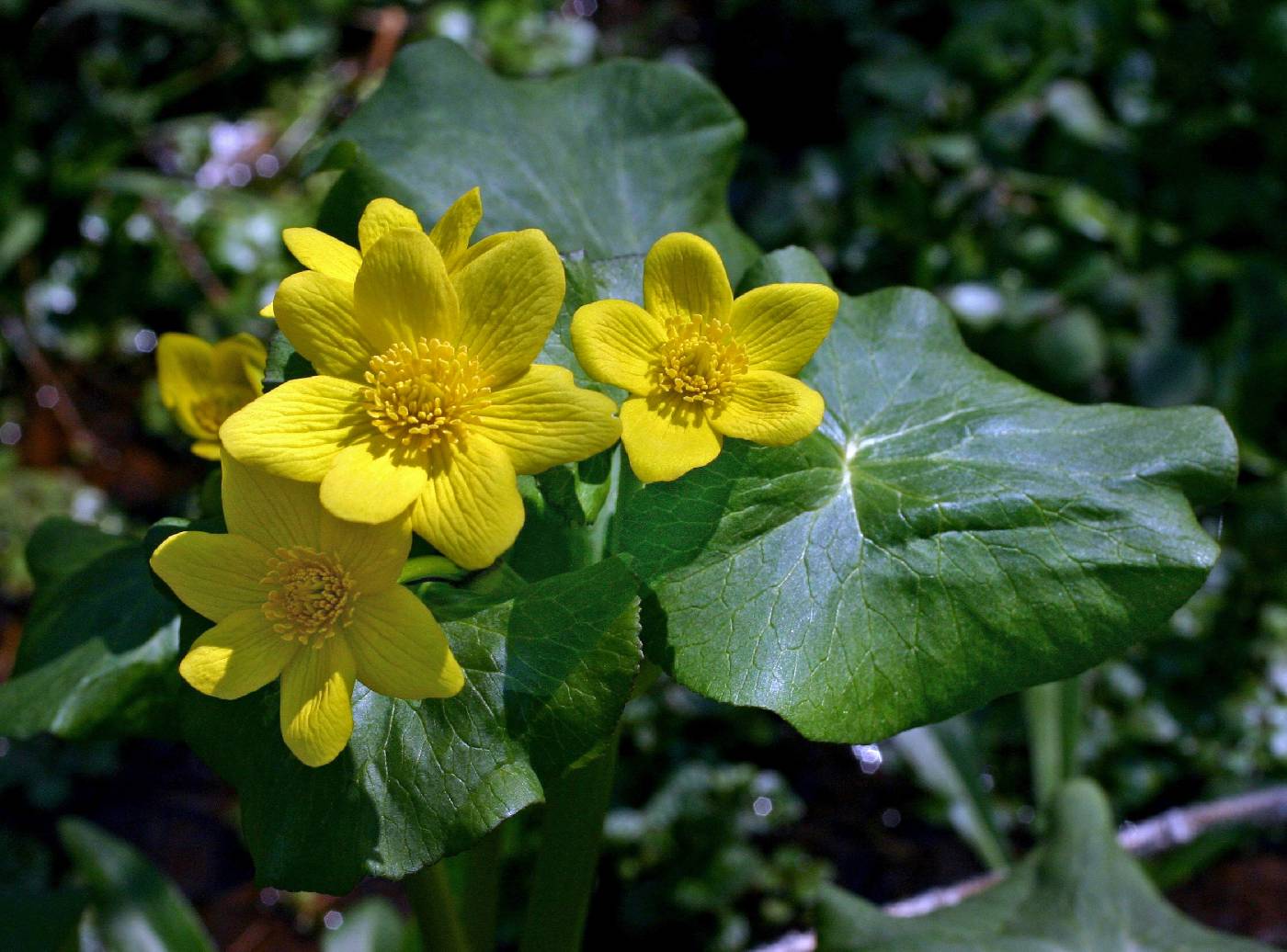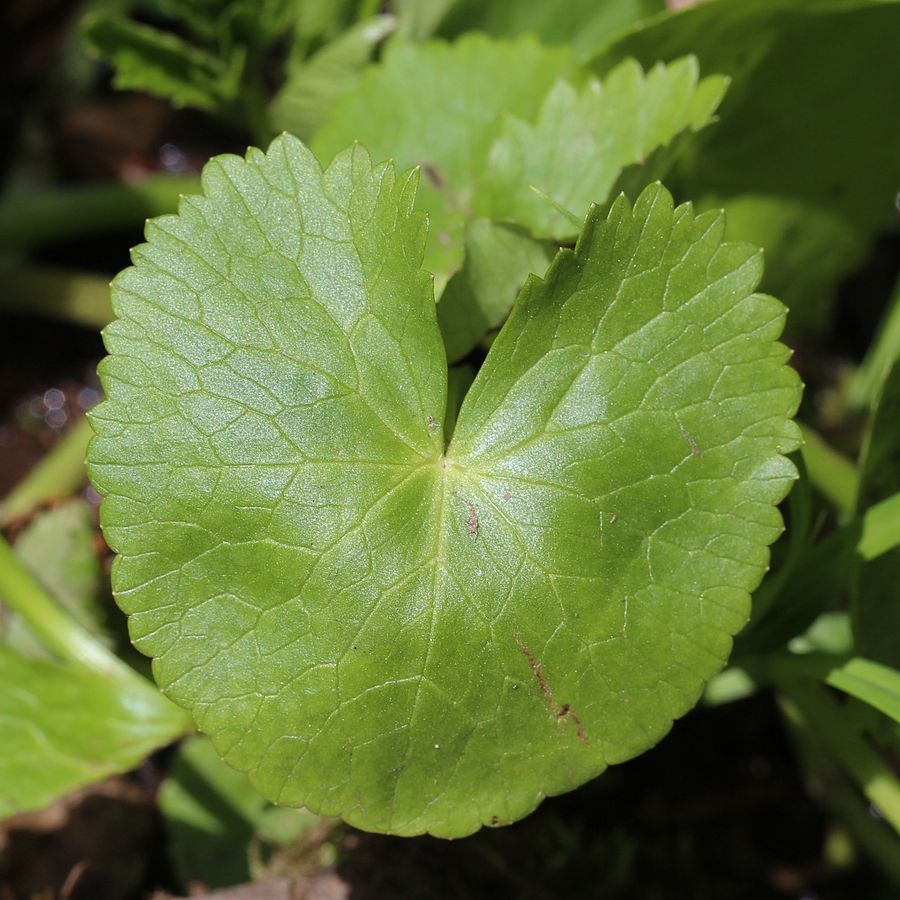Scientific name: Caltha palustris
Suggested pronunciation: KAL-tha pal-US-triss
Common names: marsh marigold, cowslip, cowflock, kingcup

Caltha palustris, Wikimedia Commons, Llez (CC BY-SA 3.0).
Family: Ranunculaceae
Article by Jeanne Gozigian
It is ironic that such a true harbinger of Spring, the marsh marigold, is not a marigold at all!
Rather, this showy, shiny, bright yellow flower with 5 to 9 sepals, 1”-1 ½” in width, growing in clusters, is a member of the buttercup, Ranunculaceae, family. Blooming from mid-April to June, it is one of the first colorful odes to joy after a long winter:
“One morning very early, before the sun was up, I rose and found the shining dew on every buttercup”
from the poem, “My Little Shadow”, by Robert Louis Stevenson.
For more on the name, marigold, see the March 1, 2019, Plant of the Month article about the desert marigold, Baileya multiradiata. Caltha means goblet, thus the common name, kingcup, and palustris means, of marshland.
As suggested by their name, these beauties like to have wet feet, growing along streams and in marshy areas. In Santa Fe, New Mexico, they thrive above the city in the Sangre de Cristo mountains at up to 10,000 feet in elevation, but they also grew along the streams of my grandparents’ dairy farm in upstate New York at much lower elevations. They take a mounding form, standing 8”-14”tall.

Seeds are available commercially, so if home gardeners have a suitable wet site, they can plant them in the fall for a spring display. They were often picked by farmers to be sold in bouquets before other seasonal flowers were blooming. The farmers must have had some magical formula to keep them from early wilting, a curse for wildflower picking.

Paul Rothrock. SEINet (CC BY-SA).
Farmers are also said to be responsible for the common name, cowslips, cow’s lips, theorizing that the yellow color of butter came from cows eating marsh marigolds. Another irony! Cows do not graze on Caltha palutris; the whole plant is poisonous to them, likewise to horses and humans. Only moose seem to tolerate it. The culprit is a yellow oil called, protoanemonin, an acid which can also be a skin irritant.

Leaf Blade
Alpsdake from Wikimedia Commons
CC BY-SA 3.0
Again, ironically, when dried in hay, cows and horses can safely chomp down on marsh marigolds. Humans will try to eat almost anything and have discovered that no part of this plant can be eaten raw; however, fresh small green leaves can be boiled in 2-3 changes of water and enjoyed like spinach. Hello, Popeye! After like treatment, buds can be pickled in vinegar and used like capers. Protoanemonin is destroyed by heat. Like many herbaceous plants, people have found, or imagined, medicinal uses for marsh marigolds as a diuretic, emetic, expectorant and application for removal of warts. Given its powerful toxicity, I would give it a pass! A yellow dye can be produced from its flowers.
The scalloped basal leaves, 3”-6” long , are oval or heart shaped with a deep, narrow notch. This native, rhizomatous perennial occurs from Newfoundland and Alaska, south to Nebraska, Tennessee (where it is becoming rare), and North Carolina (endangered, perhaps because of bouquet picking?). It does well in full sun, part shade and wooded areas. An added attraction is that it is deer, insect and disease resistant.
Not surprising!
Sources:
Marsh Marigold: Pictures, Flowers., Leaves, Identification
Retrieved: September 18, 2021
www.ediblewildfood.com-marshmarigold
Marsh-marigold/The Wildlife Trust
Retrieved: September 18, 2021
www.wildlifetrusts.org-marshmarigold
Medicinal Herbs: Marsh Marigold C.P., March 20, 2021
Retrieved: October 29, 2021
naturalmedicinalherbs.net/herbs/caltha-palustris=marshmarigold.php
Plant of the Month, desert marigold, March 1, 2019
Retrieved October 29, 2021
santafebotanicalgarden.org
Stevenson, Robert Louis, A Child’s Garden of Verses
Whitman Publishing Co, Racine, Wisconsin, 1917
Sanders, Jack, The Secrets of Wildflowers
Lyons Press, Guilford CT, 2003
Yellow Marsh Marigold
Retrieved September 18, 2021
www.fs.fed.us-wildflowers-plant-of-the-week


